Business Finance: Applying Time Value of Money in Decisions
VerifiedAdded on 2023/03/21
|5
|1228
|39
Essay
AI Summary
This essay provides a comprehensive analysis of the application of time value of money concepts in financial management decisions. It examines the fundamentals of time value of money, including the reasons why money's value changes over time due to risk, inflation, and consumption preferences. The essay elucidates the discounting and compounding processes, highlighting the rationale for using discounting over compounding in investment decisions. It also discusses the discount rate, its components (risk-free rate and required rate of return), and the reasons for using different discount rates for evaluating various investment opportunities based on their specific risk profiles. The essay concludes by emphasizing the importance of the discounting rate in evaluating investment decisions, providing a valuable resource for understanding the time value of money in finance.
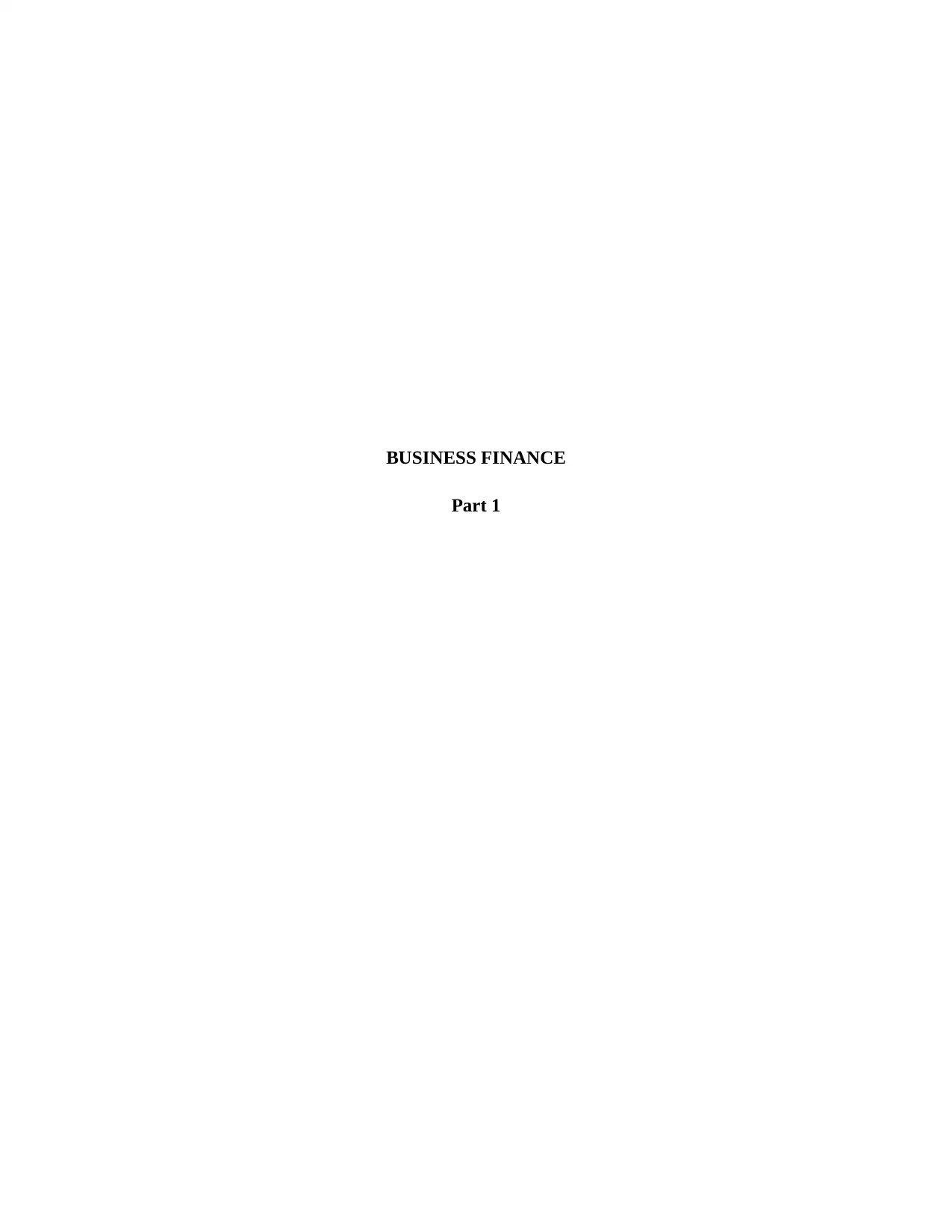
BUSINESS FINANCE
Part 1
Part 1
Paraphrase This Document
Need a fresh take? Get an instant paraphrase of this document with our AI Paraphraser
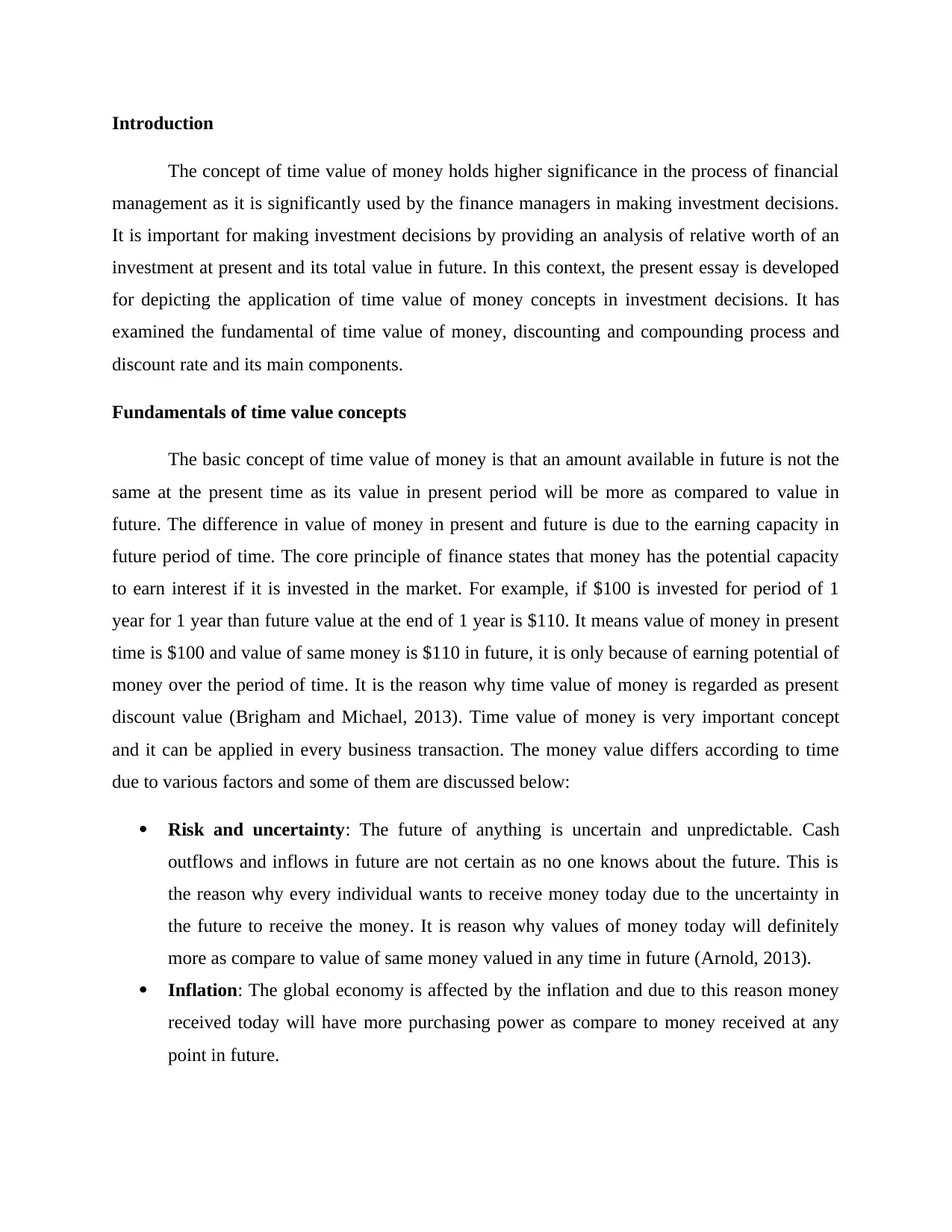
Introduction
The concept of time value of money holds higher significance in the process of financial
management as it is significantly used by the finance managers in making investment decisions.
It is important for making investment decisions by providing an analysis of relative worth of an
investment at present and its total value in future. In this context, the present essay is developed
for depicting the application of time value of money concepts in investment decisions. It has
examined the fundamental of time value of money, discounting and compounding process and
discount rate and its main components.
Fundamentals of time value concepts
The basic concept of time value of money is that an amount available in future is not the
same at the present time as its value in present period will be more as compared to value in
future. The difference in value of money in present and future is due to the earning capacity in
future period of time. The core principle of finance states that money has the potential capacity
to earn interest if it is invested in the market. For example, if $100 is invested for period of 1
year for 1 year than future value at the end of 1 year is $110. It means value of money in present
time is $100 and value of same money is $110 in future, it is only because of earning potential of
money over the period of time. It is the reason why time value of money is regarded as present
discount value (Brigham and Michael, 2013). Time value of money is very important concept
and it can be applied in every business transaction. The money value differs according to time
due to various factors and some of them are discussed below:
Risk and uncertainty: The future of anything is uncertain and unpredictable. Cash
outflows and inflows in future are not certain as no one knows about the future. This is
the reason why every individual wants to receive money today due to the uncertainty in
the future to receive the money. It is reason why values of money today will definitely
more as compare to value of same money valued in any time in future (Arnold, 2013).
Inflation: The global economy is affected by the inflation and due to this reason money
received today will have more purchasing power as compare to money received at any
point in future.
The concept of time value of money holds higher significance in the process of financial
management as it is significantly used by the finance managers in making investment decisions.
It is important for making investment decisions by providing an analysis of relative worth of an
investment at present and its total value in future. In this context, the present essay is developed
for depicting the application of time value of money concepts in investment decisions. It has
examined the fundamental of time value of money, discounting and compounding process and
discount rate and its main components.
Fundamentals of time value concepts
The basic concept of time value of money is that an amount available in future is not the
same at the present time as its value in present period will be more as compared to value in
future. The difference in value of money in present and future is due to the earning capacity in
future period of time. The core principle of finance states that money has the potential capacity
to earn interest if it is invested in the market. For example, if $100 is invested for period of 1
year for 1 year than future value at the end of 1 year is $110. It means value of money in present
time is $100 and value of same money is $110 in future, it is only because of earning potential of
money over the period of time. It is the reason why time value of money is regarded as present
discount value (Brigham and Michael, 2013). Time value of money is very important concept
and it can be applied in every business transaction. The money value differs according to time
due to various factors and some of them are discussed below:
Risk and uncertainty: The future of anything is uncertain and unpredictable. Cash
outflows and inflows in future are not certain as no one knows about the future. This is
the reason why every individual wants to receive money today due to the uncertainty in
the future to receive the money. It is reason why values of money today will definitely
more as compare to value of same money valued in any time in future (Arnold, 2013).
Inflation: The global economy is affected by the inflation and due to this reason money
received today will have more purchasing power as compare to money received at any
point in future.
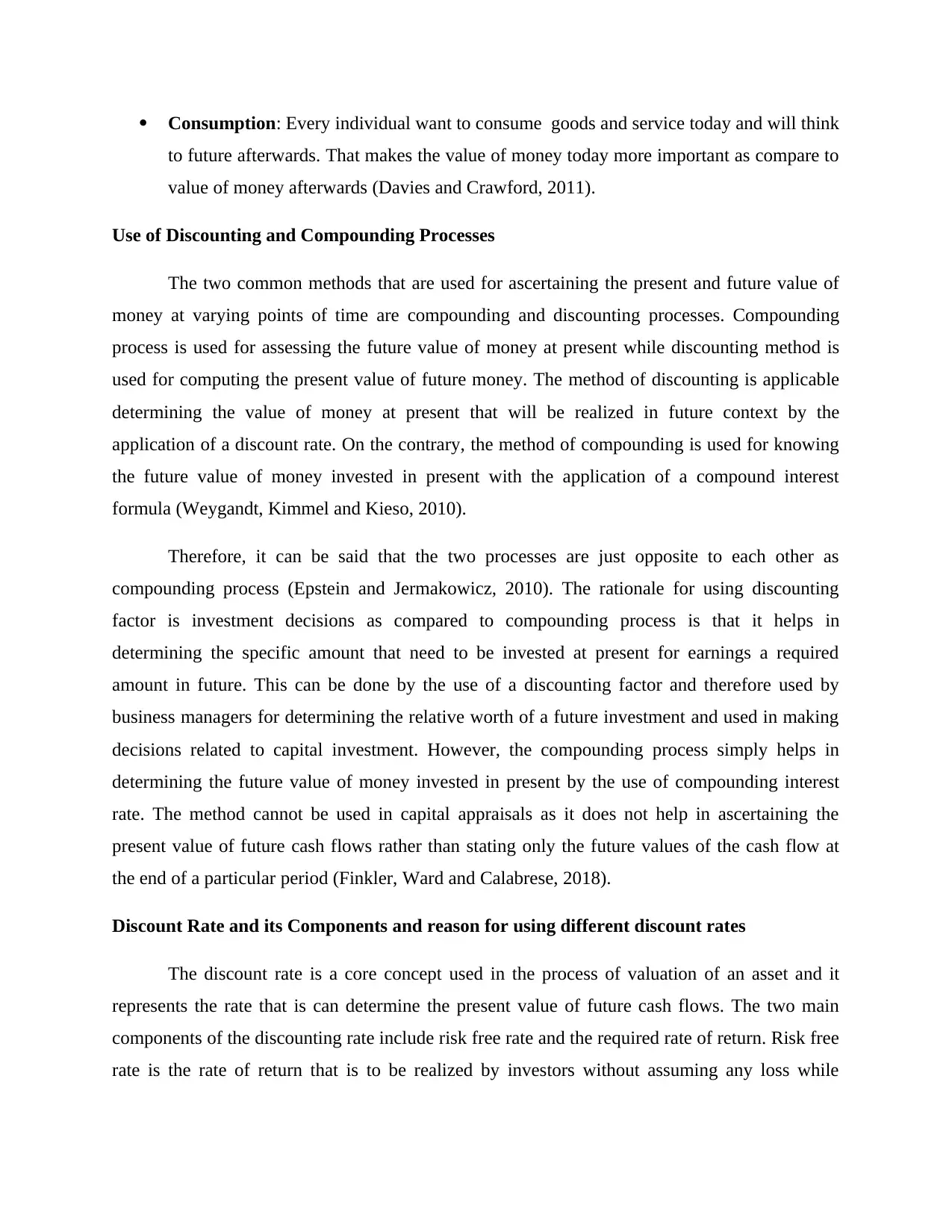
Consumption: Every individual want to consume goods and service today and will think
to future afterwards. That makes the value of money today more important as compare to
value of money afterwards (Davies and Crawford, 2011).
Use of Discounting and Compounding Processes
The two common methods that are used for ascertaining the present and future value of
money at varying points of time are compounding and discounting processes. Compounding
process is used for assessing the future value of money at present while discounting method is
used for computing the present value of future money. The method of discounting is applicable
determining the value of money at present that will be realized in future context by the
application of a discount rate. On the contrary, the method of compounding is used for knowing
the future value of money invested in present with the application of a compound interest
formula (Weygandt, Kimmel and Kieso, 2010).
Therefore, it can be said that the two processes are just opposite to each other as
compounding process (Epstein and Jermakowicz, 2010). The rationale for using discounting
factor is investment decisions as compared to compounding process is that it helps in
determining the specific amount that need to be invested at present for earnings a required
amount in future. This can be done by the use of a discounting factor and therefore used by
business managers for determining the relative worth of a future investment and used in making
decisions related to capital investment. However, the compounding process simply helps in
determining the future value of money invested in present by the use of compounding interest
rate. The method cannot be used in capital appraisals as it does not help in ascertaining the
present value of future cash flows rather than stating only the future values of the cash flow at
the end of a particular period (Finkler, Ward and Calabrese, 2018).
Discount Rate and its Components and reason for using different discount rates
The discount rate is a core concept used in the process of valuation of an asset and it
represents the rate that is can determine the present value of future cash flows. The two main
components of the discounting rate include risk free rate and the required rate of return. Risk free
rate is the rate of return that is to be realized by investors without assuming any loss while
to future afterwards. That makes the value of money today more important as compare to
value of money afterwards (Davies and Crawford, 2011).
Use of Discounting and Compounding Processes
The two common methods that are used for ascertaining the present and future value of
money at varying points of time are compounding and discounting processes. Compounding
process is used for assessing the future value of money at present while discounting method is
used for computing the present value of future money. The method of discounting is applicable
determining the value of money at present that will be realized in future context by the
application of a discount rate. On the contrary, the method of compounding is used for knowing
the future value of money invested in present with the application of a compound interest
formula (Weygandt, Kimmel and Kieso, 2010).
Therefore, it can be said that the two processes are just opposite to each other as
compounding process (Epstein and Jermakowicz, 2010). The rationale for using discounting
factor is investment decisions as compared to compounding process is that it helps in
determining the specific amount that need to be invested at present for earnings a required
amount in future. This can be done by the use of a discounting factor and therefore used by
business managers for determining the relative worth of a future investment and used in making
decisions related to capital investment. However, the compounding process simply helps in
determining the future value of money invested in present by the use of compounding interest
rate. The method cannot be used in capital appraisals as it does not help in ascertaining the
present value of future cash flows rather than stating only the future values of the cash flow at
the end of a particular period (Finkler, Ward and Calabrese, 2018).
Discount Rate and its Components and reason for using different discount rates
The discount rate is a core concept used in the process of valuation of an asset and it
represents the rate that is can determine the present value of future cash flows. The two main
components of the discounting rate include risk free rate and the required rate of return. Risk free
rate is the rate of return that is to be realized by investors without assuming any loss while
⊘ This is a preview!⊘
Do you want full access?
Subscribe today to unlock all pages.

Trusted by 1+ million students worldwide
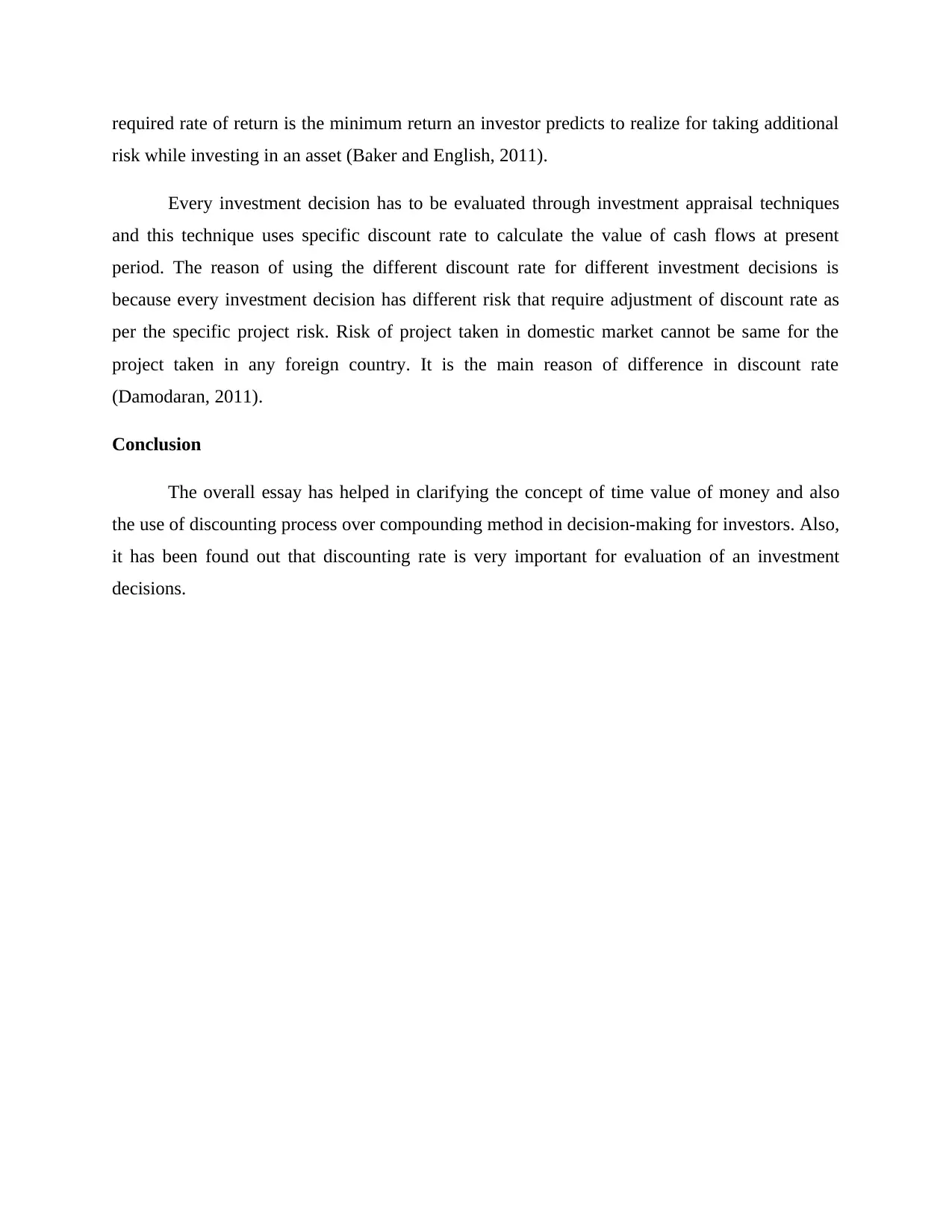
required rate of return is the minimum return an investor predicts to realize for taking additional
risk while investing in an asset (Baker and English, 2011).
Every investment decision has to be evaluated through investment appraisal techniques
and this technique uses specific discount rate to calculate the value of cash flows at present
period. The reason of using the different discount rate for different investment decisions is
because every investment decision has different risk that require adjustment of discount rate as
per the specific project risk. Risk of project taken in domestic market cannot be same for the
project taken in any foreign country. It is the main reason of difference in discount rate
(Damodaran, 2011).
Conclusion
The overall essay has helped in clarifying the concept of time value of money and also
the use of discounting process over compounding method in decision-making for investors. Also,
it has been found out that discounting rate is very important for evaluation of an investment
decisions.
risk while investing in an asset (Baker and English, 2011).
Every investment decision has to be evaluated through investment appraisal techniques
and this technique uses specific discount rate to calculate the value of cash flows at present
period. The reason of using the different discount rate for different investment decisions is
because every investment decision has different risk that require adjustment of discount rate as
per the specific project risk. Risk of project taken in domestic market cannot be same for the
project taken in any foreign country. It is the main reason of difference in discount rate
(Damodaran, 2011).
Conclusion
The overall essay has helped in clarifying the concept of time value of money and also
the use of discounting process over compounding method in decision-making for investors. Also,
it has been found out that discounting rate is very important for evaluation of an investment
decisions.
Paraphrase This Document
Need a fresh take? Get an instant paraphrase of this document with our AI Paraphraser
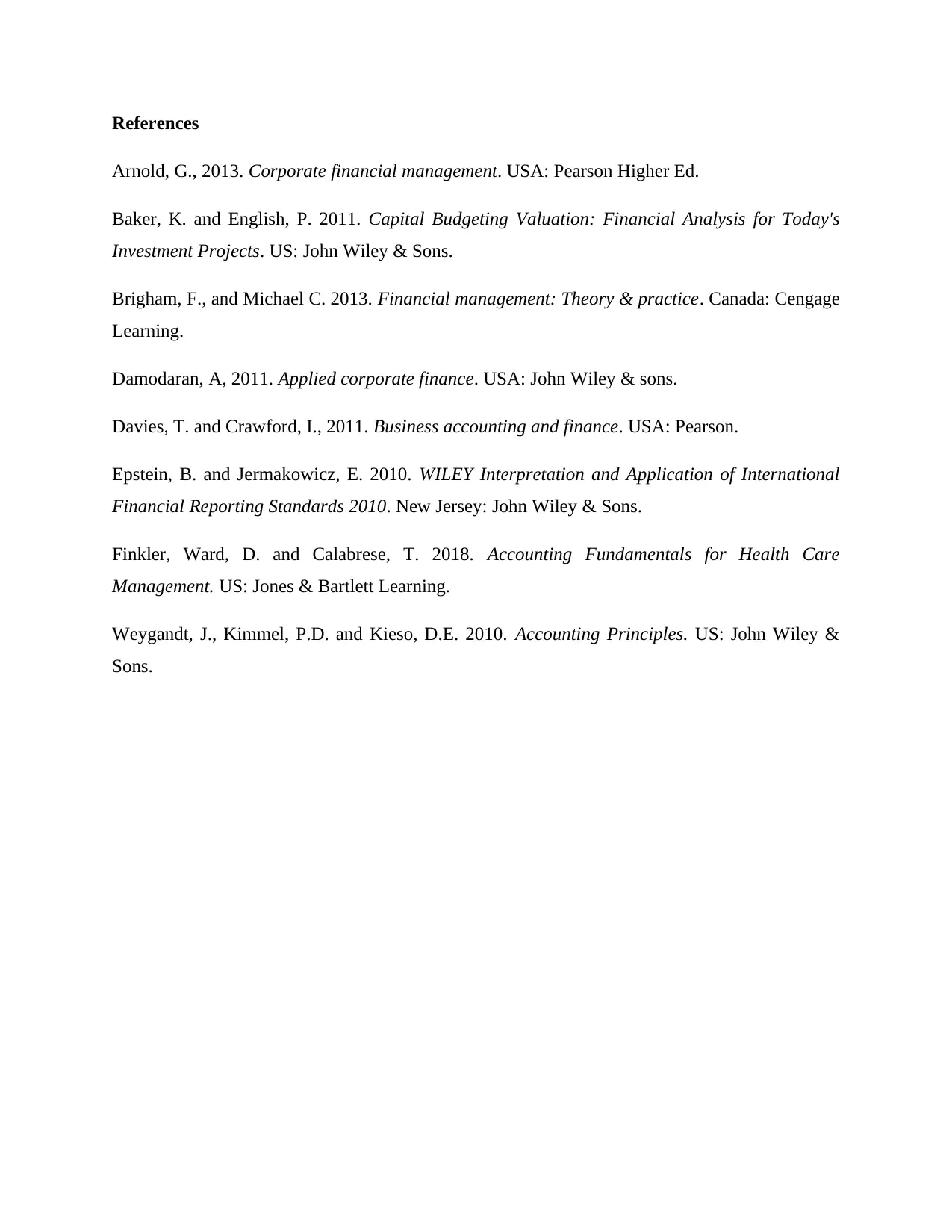
References
Arnold, G., 2013. Corporate financial management. USA: Pearson Higher Ed.
Baker, K. and English, P. 2011. Capital Budgeting Valuation: Financial Analysis for Today's
Investment Projects. US: John Wiley & Sons.
Brigham, F., and Michael C. 2013. Financial management: Theory & practice. Canada: Cengage
Learning.
Damodaran, A, 2011. Applied corporate finance. USA: John Wiley & sons.
Davies, T. and Crawford, I., 2011. Business accounting and finance. USA: Pearson.
Epstein, B. and Jermakowicz, E. 2010. WILEY Interpretation and Application of International
Financial Reporting Standards 2010. New Jersey: John Wiley & Sons.
Finkler, Ward, D. and Calabrese, T. 2018. Accounting Fundamentals for Health Care
Management. US: Jones & Bartlett Learning.
Weygandt, J., Kimmel, P.D. and Kieso, D.E. 2010. Accounting Principles. US: John Wiley &
Sons.
Arnold, G., 2013. Corporate financial management. USA: Pearson Higher Ed.
Baker, K. and English, P. 2011. Capital Budgeting Valuation: Financial Analysis for Today's
Investment Projects. US: John Wiley & Sons.
Brigham, F., and Michael C. 2013. Financial management: Theory & practice. Canada: Cengage
Learning.
Damodaran, A, 2011. Applied corporate finance. USA: John Wiley & sons.
Davies, T. and Crawford, I., 2011. Business accounting and finance. USA: Pearson.
Epstein, B. and Jermakowicz, E. 2010. WILEY Interpretation and Application of International
Financial Reporting Standards 2010. New Jersey: John Wiley & Sons.
Finkler, Ward, D. and Calabrese, T. 2018. Accounting Fundamentals for Health Care
Management. US: Jones & Bartlett Learning.
Weygandt, J., Kimmel, P.D. and Kieso, D.E. 2010. Accounting Principles. US: John Wiley &
Sons.
1 out of 5
Related Documents
Your All-in-One AI-Powered Toolkit for Academic Success.
+13062052269
info@desklib.com
Available 24*7 on WhatsApp / Email
![[object Object]](/_next/static/media/star-bottom.7253800d.svg)
Unlock your academic potential
Copyright © 2020–2025 A2Z Services. All Rights Reserved. Developed and managed by ZUCOL.





